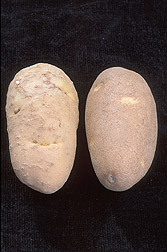This page has been archived and is being provided for reference purposes only. The page is no longer being updated, and therefore, links on the page may be invalid.
|
|
Wild Potatoes Tapped for Nematode DefenseBy Jan SuszkiwMarch 23, 2004 Wild potatoes growing high above the desert in southeastern Arizona may hold the genetic keys to a defense against the Columbia root-knot nematode, according to Agricultural Research Service scientists. The tiny, wormlike pest is especially troublesome in Washington, Oregon and Idaho, where more than half of the U.S. tuber crop is grown. Growers fumigate fields to keep the nematode from damaging the crop's roots. Annually, they'll spend $20 million on fumigants to prevent crop losses of $40 million. Since resistance isn't found in U.S. potatoes, ARS scientists Chuck Brown and John Bamberg sought to fortify the crop with useful new genes from its wild mountain relatives, including Solanum fendleri, a native of the U.S. Southwest and northern Mexico. Bamberg manages S. fendleri seedlots at the ARS U.S. Potato Genebank in Sturgeon Bay, Wis. Early tests in Prosser, Wash., showed some specimens were nematode resistant. The researchers decided to repeat the tests. But first, they wished to see for themselves where the seed they had used originally came from, collect new specimens and answer the question: "Why would a wild potato be resistant to an agricultural pest?" In September 2002, this interest took them to the Huachuca and Chiricahua mountains in Arizona. There, they collected small tubers and seed from natural stands of S. fendleri at two sites at altitudes of 6,000-8,000 feet. Upon returning, they grew new plants from the seed and tubers they had collected. Later, they assessed the nematode resistance or susceptibility, observing that some individuals from the collection were good hosts (susceptible), while others were not, meaning they resisted the pest. Crossing the resistant S. fendleri plants with cultivated potatoes, however, is difficult to do because of chromosome number differences. Brown, at the ARS Vegetable and Forage Crops Research Unit in Prosser, tackled this hurdle using a breeding technique called "bridging crosses." The resulting plants are now growing in a greenhouse, and Brown plans to cross them with cultivated sources, setting the stage for breeders to develop new, nematode-resistant commercial varieties. ARS is the U.S. Department of Agriculture's chief scientific research agency. |

